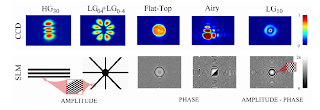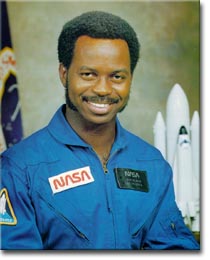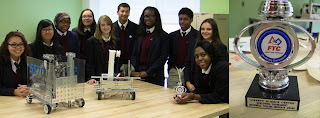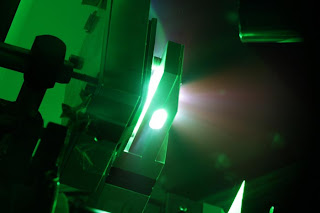All Posts (6506)
Brian Carter knows how important it is for his son, Adante, to get a good education. Half of Kentucky’s African American males score below the basic level in math, and he doesn’t want Adante to be one of those. To provide a challenging environment and prepare Adante for a rewarding career later in life, Brian enrolled him in the STEM (Science, Technology, Engineering and Math) Academy.
United Way of the Bluegrass partnered with First Bracktown Inc., University of Kentucky, Fayette County Public Schools and the JP Morgan Chase Foundation to create the STEM Academy. Adante and 39 other middle school males attend weekly out-of-school programming with STEM focused activities.
And, it’s working. Seventy percent of STEM Academy students have improved their overall grades. These amazing results prove all children can succeed in school.
“Any program that supports the future of our children is important,” says Brian. “Having a program like this is beneficial to both the kids and society as a whole.”
 |
| "These first years set the stage not just for school, but for life." |
Scientific American: Why Hasn't the Whole Universe Collapsed into an Enormous Black Hole?
 |
Sixty-five African-American middle-school girls from the Dallas Independent School District will visit the UT Dallas campus this Saturday to walk on a liquid and solve a “whodunit” using fingerprint analysis.
Held at UT Dallas and sponsored by the Dallas Chapter of The Links Inc., the STEM academy session includes an experiment using a mixture of cornstarch and water, which forms a so-called “non-Newtonian” fluid. It pours like a liquid, but behaves like a solid when force acts upon it, such as stepping on it. The girls also will meet with professional women in STEM-related careers, as well as network with female graduate students who are pursuing STEM degrees.
“This is a great opportunity for these girls to gain exposure to both academic and professional opportunities in STEM fields,” said Felecia Pittman, professional development associate with UT Dallas’ Center for STEM Education and Research. The center is partnering with The Links and coordinating the curriculum for the event.
“We hope that the girls will develop connections with some of our female students who could serve as mentors or role models,” she said.
Photo: A STEM academy session allows girls to meet with professional women in STEM-related careers, as well as female graduate students who are pursuing STEM degrees.
UT Dallas: Middle-School Girls to Get Taste of Science at STEM Academy
With working organs and a realistic face, the world’s most high-tech humanoid made his debut in London yesterday and will be a one-man show at the city’s London Science Museum starting tomorrow.
The robot goes by Rex (short for robotic exoskeleton) or Million-Dollar Man (because that’s how much it cost to build him). Rex looks somewhat lifelike in that he has prosthetic hands, feet and a face modeled after a real man. That man is Swiss social psychologist Bertolt Meyer, who himself has a prosthetic hand. Such technology is now becoming more widely available to the general public.
But where Rex really breaks new ground is his suite of working organs. The team of roboticists, called Shadow, that created Rex incorporated various individual body parts built in labs all over the globe. He acts as a sort of showcase to demonstrate the human organs that are currently being built in the lab and what they can do.
Rex has a heart that beats with the help of a battery, and eyes that actually kind of see: Rex’s glasses send images to a microchip is his retina, which in turn sends electrical pulses to the brain, forming shapes and patterns. But the roboticists didn’t even try to tackle the complexity of the human brain this time.
Rex’s fist-sized dialysis unit works like a real kidney, and his mock spleen can filter infections from his “blood.” This filtering function could eventually be extremely helpful in a human, but Rex’s mock-circulatory system pumps a synthetic blood that is immune to infection.
Rex’s creators say he is the most complete bionic man to date.
Discovery Magazine: Bionic Man Has Fully Functional Mechanical Organs
Afro-Futuristic Vision #33 - Say Goodbye to Miss Laura – Django Unchained
Why do I always do things after all the hoopla and hype has everyone plugged in when they should be giving all their energy to early day physical exercises and spiritual work. I don’t know. Could be that when anyone jumps on a trend I look to go the opposite direction.
DJANGO UNCHAINED – SHANGO UNCHAINED
Quentin Tarratino’s film style has always been interesting to me, a homage to the old 42nd Street Movie theatres that showed 3-4 Kung-Fu Features and Street Vigilante Flicks while thick billowy clouds of Marijuana entered the lungs of the old and young. Who can say, if most attendees actually enjoyed these flicks or were just zoning in another world.
Quentin always had an interesting way of casting unsuspecting individuals who eventually take the lead in the course of the movie. Django was no different.
You can tell that he would eventually go the Western route since his cameo appearance in Sukiyaki Western Django, which was directed by Takashi Miike. Quentin played Piringo who ‘edifies a group of bandits about an old rivalry between two bitter Japanese clans, before dispatching the bandits in a brief, but violent shootout.’ http://www.metacafe.com/watch/mv-nvyQc/sukiyaki_western_django_piringos_story/
My review of Django will be based solely on my perspective as an Afro-Futurist (who is somewhat reclusive) and views the world from a dynamic of Tao and Nubian principles of energy progression. Keeping in mind, that Tarratino can only produce films from his own point of view on life and cannot be held responsible to give a full accurate perspective of our world. Although, I thought Django was very close to my AF standards.
While a majority of movie-goers were outraged with the racial slurs and epithets within the movie, there was not a surge of abandoning any form of current activity which may reflect what Europeans have labeled as slavery. Folks still went to Whole-Foods, Mickey D’s, Duane Reade, called themselves Vegan or Vegetarian, used I-Phones, voted, downloaded on Kindle, watched YouTube and more importantly watch the modern form of Mandigo Fighting (Football, Basketball and so forth). There was no dramatic drop in sports gambling, purchase of merchandise/ paraphernalia and tailgate parties.
No one abandoned the American Way of Life over the 100x Nigger was called out in Django, which would have been a bigger testament to opposing the use of the word. Nor was there a sudden increase in sales and downloads of Spike Lee’s Movies since he was the one that really bought it to our attention.
But hey, External Science is a helluva drug….
Now we got that out the way, Django…
Opening images of men in bondage walking on a chain-gang through all manner of weather. Powerful image. Since most of the world is genetically mixing in with each other physically and language-wise. We are currently in an age where that time in the Life-Story of Europeans and respectively Afrikans/Nubians, has been wiped out with elections and over-the-top episodes of Family Guy. But for me, the image of Django and the men walking in bondage, caused me to recognize that we never went through Slavery. At least not according to our own words. We were and still are used to refine mental and physical commodities by a group of individuals whose spiritual maturity is lacking. And somewhere along the line we believed and adapted the word, slavery, that was used by these individuals to describe our experience. SLAVERY IS THEIR TERMINOLOGY.
I don’t know how you watch a film, but I always watch a film as it relates to me as DjaDja, my culture and my place in this universe. I do not look for politics, economics, pop-culture or any of the other things that fill this Life-Bubble with random expressions of bottled repressed energy.
At this point, watching the film became an experience of my senses and AF reasoning plugged into the experience of Django. Most of the dialogue at this point was at a minimum and when we did here a voice, it was from one of the ‘slavers’, and his energy immediately opened the theme for others characters who shared his views…that energy being ignorance. It allowed us to see into the mentality of those certain people at that time period. At this point, it would appear that the men in captivity were surrounded by alien beings who knew little to nothing about the spirit of the land around them and less about the function of language and its overall energy. With the exception of Dr. Schultz, every time a European in this movie spoke, it came from the space of a very warlike energy; regardless if the manner of speech was with eloquent words and mannerism.
When Django was given the opportunity for mercenary work, he accepted as a way out of his current plight. Mercenary work is an age-old career, however, it may have been under different names dependant on the culture, the underlying energy of it is still the same. Django’s ‘freedom’ was accomplished by barter and trade hastened by the blood splattering of horse and man alike.Django tosses off the clothes of what the Europeans called Slavery; almost naked true to his essence for a split second. The most real and connected a man can be. Once the paperwork was accomplished, Django took the clothes of one of the men who held him in bondage since that man’s contract with this world was rapidly expired by Dr. Shultz’ gun. Taking of the clothes can be seen as taking on the identity in rouse while remaining true to oneself. It you noticed, the wind special-effect chimed in when Django removed his rags, the wind representing Shango…this was the time of Django’s transformation within the night-air, receiving Shango.
Throughout the movie, all 2 hours and 45 minutes of it, we are given over to unsanitary conditions, not so much in dealing with the Nubians in bondage, but more so within the world of Europeans living in this area of the world. Although dressed with frou frou material possessions, we get an undercurrent feeling of stench and uncleanliness.
I will not speak for others, nor force my opinions on them, but for me, clearly two worlds were running parallel, one of European Slavery Concept and the other of Django view of being thrust into a world of treachery, greed and lust. Too often, a film is based on the views of a Euro-centric nature when dealing with African-Americans (Afrikan/Nubian Descendents/Ascendents) storylines, although this was no exception…it was. In my opinion, saying that we were slaves is taking on the European view to explain our condition, rather than just using the Euro-Verb ‘Enslavement’ the actual action and not the word ‘Slave’ which is the identity.
As things progressed, it was apparent that the true savages were those who used the word Nigger like a second breath, or maybe that was the point…to be like the Nigger they could never be…
It is interesting that even German, Dr. King Schultz, was offended by his slack-jawed country backward cousins. Possibly his role represents the Europeans looking to remove themselves from that mentality or maybe they are just playing along…
I can go on and on about all the metaphysical symbolism and the cast of spells throughout the film but I won’t...
I will however, point out the areas that were of particular interest to me.
Clothing – Django’s clothing constantly evolved through the course of film. From rags to the powder blue satin colonial Mason suit to the rugged western land baron suit. Not only did the material change but it also reflected his attitude. While remaining true to his mission and his essence, the uniform changed in order to infiltrate and be taken seriously (in the context of how one expresses oneself for clarity as well as maintaining one’s camouflage—not for the purpose of changing someone’s mind so that they will respect you). At the end, his attire was well-managed and orderly, this reflected his ability to master the language of the people in this land as well as their mannerisms and customs...still remaining true to himself.
Finally at the end of the film, we see Django dressed in the colors of Shango and his mannerism enhanced by the spirit that dwells within him. “I didn’t know Burgundy was my color.”
Whipping – By far, the whipping scene was so realistic to me. If you are going to submit your torturer to the same hostility he imposed on you and there is no one with a sutra or Buddha chant around…by all means…make sure to put your whole body into it and get out all your frustration…purify your liver and toss the whip like a mic at the end of it. Make sure to spread your fingers of your free hand for balance and supreme cocking mechanism. Do not think of Indy at all. Do it right next to the tree that your brethren were whipped on and change the course of energy for that area. This scene reminded me of the Nasuwt (Ruler) Narmer from Kemet (Egypt) when he took the heads of the Hyksos/Haribus. Also, the scene seemed to symbolize the taking back of sacred teachings that’s been coveted by certain groups…the reclaiming of self from self. Dressed in a colonial suit and whipping on the colonizer shows a role reversal. One can only be a servant by giving yourself over. Towards the end of this scene we clearly see the Ka position (which is the position of the spiritual self and the utilization of space for creativity) held by Django when he and Dr. Shultz hold their hands up. This happens once more towards the end when Django gives up and throws off his coat (once again the wind special effect follows in; showing the exit of Shango’s spirit) then places his hands in the Ka position. Although it can be seen as surrender, actually it was Django manipulating the space and shedding a role of Shango in order to throw off his enemies. Now that they seen no threat because of the absence of Shango they lowered their guards.
If you are going to submit your torturer to the same hostility he imposed on you and there is no one with a sutra or Buddha chant around…by all means…make sure to put your whole body into it and get out all your frustration…purify your liver and toss the whip like a mic at the end of it. Make sure to spread your fingers of your free hand for balance and supreme cocking mechanism. Do not think of Indy at all. Do it right next to the tree that your brethren were whipped on and change the course of energy for that area. This scene reminded me of the Nasuwt (Ruler) Narmer from Kemet (Egypt) when he took the heads of the Hyksos/Haribus. Also, the scene seemed to symbolize the taking back of sacred teachings that’s been coveted by certain groups…the reclaiming of self from self. Dressed in a colonial suit and whipping on the colonizer shows a role reversal. One can only be a servant by giving yourself over. Towards the end of this scene we clearly see the Ka position (which is the position of the spiritual self and the utilization of space for creativity) held by Django when he and Dr. Shultz hold their hands up. This happens once more towards the end when Django gives up and throws off his coat (once again the wind special effect follows in; showing the exit of Shango’s spirit) then places his hands in the Ka position. Although it can be seen as surrender, actually it was Django manipulating the space and shedding a role of Shango in order to throw off his enemies. Now that they seen no threat because of the absence of Shango they lowered their guards.
StoryTime – In the scene where Dr. Shultz explains the explaination of Broomhilde’s name, we see Django sitting holding his knees listening and curious about the tale the way a child would be. This same position is down throughout the world during storyteller time and is also a meditative posture to enter the unconscious. This was another way for Django to build the energy within himself to commit to his mission. Another way to bring forth the Shango essence as well Heru consciousness.
This was another way for Django to build the energy within himself to commit to his mission. Another way to bring forth the Shango essence as well Heru consciousness.
It takes place again when Django sat in the akimbo posture and explained to his transporters from Le Quint about a bounty they could partake in exchange for his freedom. He uses the gift of speech to lull them into lowering their guard. Then they ‘cut-him-loose’ (Django Unchained). And gave him a firearm…iron. Once that happened, Shango (related to metal weaponry) was re-kindled and it was on. Bringing thundering sound from the pistols and explosive Dynamite, Django appears from out a cloud of smoke, cleans himself with water (a conduit to the spirit world) and is about his way. At the appearance of Metal…Django became Shango.
of smoke, cleans himself with water (a conduit to the spirit world) and is about his way. At the appearance of Metal…Django became Shango.
Visions of BroohHilde as Orishas – Throughout the film, Broomhilde appears as a many different Orishas before Django got to her. One time between within the woods as Oshun dressed in all Yellow. And another time as Yemaya (Orisha of Sea and Rivers) 
 when Django was bathing, this was another initiation into the spirit world and preparation for battle.
when Django was bathing, this was another initiation into the spirit world and preparation for battle.
More importantly, this is one of the only movies where a Nubian couple were re-united and supported one another. Where a Nubian Man held a woman in his arms. This was a film about remembering our internal technology and how that ability works with the unification of man and woman. They destroyed the house that symbolized control and left out the Pylons never to return. Pylon or gateways in front of buildings hold the program of the residence.
Django proceeded to draw a new sphere of life with his horse and then walked slowly out its shell, symbolizing new life…it you see it this way…otherwise…this was a period slavery film to those that accept slavery is the correct way to explain that condition.
“NOW ALL YOU BLACK FOLKS, I SUGGEST THAT YOU GET AWAY FROM ALL THESE WHITE FOLKS.”
Meaning move back into your own perspective of thought.
“BYE MISS LAURA.”
Say GoodBye to your trained way of thinking which breeds the imaginary view of dichotomy.
And as we know from Dr. Shultz…Bye is Bye….not see you later….
Return to Internal Technology….
Rise in Excellence,
DjaDja N Medjay
African physicists build the first laser with a beam that can be controlled and shaped digitally
TECHNOLOGY REVIEW: Lasers are one of the emblematic technologies of the modern world. The chances are that most readers will be less than a metre away from a laser of some kind as they read this. Lasers fill our world.
In principle, they are simple devices. They consist of a couple of mirrors, a source of energy, usually light, and a lasing cavity in which the light can bounce back and forth.
The trick is to fill the lasing cavity with a material known as a gain medium which amplifies at a specific frequency when stimulated by light of another frequency. When this amplified light is directed out of the cavity, using a half-mirror, it forms a narrow beam of coherent light of a single specific frequency–a laser beam.
For many applications, the shape of this beam– the way the light intensity varies across the beam–is important.
But because these devices are essentially bolted on to the front of a laser, they all require expensive custom optics that have to be calibrated each time they are changed.
Today, however, Sandile Ngcobo at the University of KwaZulu–Natal in South Africa and few buddies, say they’ve worked out a way round this. And they've designed and built a device to test their idea.
The solution is simple. Instead of putting a spatial light modulator in front of the laser, they’ve built one in to the device, where it acts as the mirror at one end of the cavity. In this way, the spatial light modulator shapes the beam as it is being amplified.
Physics arXiv: The digital laser
(The Root) -- At The Root, we believe that Black History Month is not just a time to reflect on the past; it's also a time to look forward. There's no better way to honor our ancestors than to highlight the success their hard work has wrought -- embodied in the accomplishments of our young people.
That's why every year, The Root embarks on a nationwide search for 25 of the brightest African-American innovators between the ages of 16 and 22 for our annual Young Futurists list. We look for students and recent graduates who are making waves in the fields of business, green innovation, social activism, science and the arts and who use their talents to make the world a better place.
The Root: Bright Future: 25 Young Black Innovators
I was actually looking for a video of him playing the saxophone in orbit and happened upon this history by ABCNEWS.com. Related to the previous post: his PhD was in Laser Physics from MIT.
"Education was the secular god of the black community" (a quote I remember, but have no sources for it).
"Those who have no record of what their forebears have accomplished lose the inspiration which comes from the teaching of biography and history.
"When you control a man's thinking you do not have to worry about his actions." Carter G. Woodson
NASA: Dr. Ronald E. McNair
ADDED: When I lived in Austin, Texas, I recalled meeting Dr. McNair when I was an undergraduate at North Carolina A&T State University. I was in AFROTC, marched in the parade in his honor after his first mission, and introduced him at the Army/Air Force ROTC joint banquet. It was a busy weekend.
"Whenever you're in Texas, you should give me a call."
So I did. Back then, I called information; asked for Ronald Ervin McNair in Houston, Texas. That was as close as "Googling it" as we got back then.
I got to speak to him for a good three hours. I found out some things:
- 5 weeks before his dissertation defense, someone purged his data (also known as sabotage). Without data, he'd essentially have failed to get his PhD. He said he stayed up for 3 weeks and re-accomplished 5 years of research. He slept for a week after that.
- He was planning to leave NASA and go into academia. Challenger would be "his last mission." That was sadly true. It devastated me, and inspired some creative writing in his honor.
- A lot of his determination he learned as a participant on the school karate team, which a the time (according to my Calculus instructor and his teammate Dr. Casterlow), you could get a disqualification for "unnecessary redness of the skin."
Recalling this makes me determined to stay in science, contribute, help when and if I can, and stand on the shoulder of this and other giants (he was actually only 5'6", but you get the idea).
“When getting an education is a revolutionary act & dreams are the province of men,” Stanley Tucci.
The Joint School of Nanoscience and Nanoengineering is a collaborative project of North Carolina A&T State University and the University of North Carolina at Greensboro.
JSNN’s mission is to train students to conduct basic and applied research in nanoscience and nanoengineering, and to work closely with the Piedmont Triad community to help enhance opportunities for economic and academic growth through its outreach and engagement activities.
Although Nanoscience and Nanoengineering deal with structures that are invisible to the human eye, their potential to improve daily life is quite substantial. For example as you are reading this, nanoscience and nanoengineering are providing new means of drug delivery, new dental adhesives, new cosmetics, new heat resistant coatings, and a range of other products that can make our lives safer and more productive. The advances in nanoscience and nanoengineering mean that more corporations are forming to design and produce nanoproducts. The financial implications of these new industries will be significant. According to Lux Research, the projected economic impact of nanotechnology on the global economy is $3.1 trillion by 2015. JSNN seeks to develop collaborations with the local and regional businesses that will raise the Triad’s Nanotechnology profile with the goal of attracting new industry and investment to the area and by doing so helping to stimulate the economic growth.1
Federal funding of a prestigious research institute at N.C. A&T State University that is developing new kinds of biomaterials for use in regenerative medicine has been extended beyond its five-year term.
The extension will bring millions of additional dollars to A&T and give the school more time to develop technologies with commercial potential. It will also increase the possibility of lucrative partnerships with Triad nanotechnology and medical companies.
Officials with the Engineering Research Center for Revolutionizing Metallic Biomaterials said they have received the results of a critical review by the National Science Foundation. The NSF awarded N.C. A&T a research grant worth about $18.5 million over five years to establish the ERC in 2008.2
1. Joint School of Nanoscience and Nanoengineering
2. The Business Journal - N.C. A&T State gets key funding increase for research center
The LEAP (Leadership, Education, and Partnership) Academy University Charter School is a kindergarten through 12th-grade (K-12) public charter school that serves Camden City with one core principle: all children and families deserve access to a quality public education.
Since 1997, LEAP has become a national model for urban education. It provides a high quality, holistic education for 1,000 urban learners and families, while guaranteeing every LEAP graduate an opportunity to earn a college degree.
LEAP Academy's three academic units—LEAP Lower School (K-6), LEAP Upper School (7-12) and a specialized STEM High School (9-12)—promote high expectations for students, personal development and successful college and career goals.
For more than 15 years this innovative approach has translated into tremendous success for students and families. Each year LEAP Academy graduates 100 percent of its senior class with all alumni admitted to college, where they are shaping their futures and the future of Camden City.
The Fabrication Lab (Fab Lab) at the STEM campus is a workshop where students can take their ideas through a complete process from conception to reality. One side of the Fab Lab holds computers with Computer-Aided Design (CAD) software where students draft their ideas. CAD software, Google SketchUp and Autodesk Inventor, allow students to create 3D digital prototypes. The other side of the lab houses machinery that brings students' 3D designs to life.
The CAD Software on the computers and the machinery in the Fab Lab work together enabling students to be creative, imaginative, and highly practical. The Fab Lab at LEAP Academy STEM is a place where students can identify needs and create real, working solutions for social problems in the community. For example, students can use the Fab Lab to design and create a home water filtration system to address the issue of clean water in Camden. Simultaneously, the Fab Lab encourages innovation and community engagement while teaching STEM skills and real world application.
More Information Contact
Dr. Alex Nieves, Director, Fabrication Lab
alex.nieves@camden.rutgers.edu | 856. 614.3292 | Extension 7320
 |
| Physics World |
Physicists in the UK have come up with a new way of storing a handful of photons in an ultracold atomic gas, in which strong interactions between neighbouring photons can be switched on and off using microwaves. The team believes that the technique could be used to create optical logic gates in which single photons could be processed one at a time. The method could also prove useful for connecting quantum-computing devices based on different technologies.
Optical photons make very good "flying" quantum bits (qubits) because they can travel hundreds of kilometres through fibres without losing their quantum information. However, it is very difficult to get such photons to interact either with each other or with "stationary" qubits such as those based on trapped ions or tiny pieces of superconductor. Exchanging quantum information between such devices can therefore be tricky.
What Charles Adams and colleagues at Durham University have now done is come up with a way of storing individual optical photons in highly excited states of an atomic gas. Once stored, the photons can be made to interact strongly, before being released again. An important feature of the technique is that it uses microwaves, which are also used to control some types of stationary qubit.
The Durham experiment involves holding up to 100 rubidium atoms in an optical trap created at the focus of a laser beam, before two pulses of light are fired at the trapped atoms. One pulse is "signal" light that is to be stored and the other is "control" light. The control light allows 10 or so neighbouring rubidium atoms to absorb a signal photon, creating a collective state called a "Rydberg polariton". Such a state is similar to that of a Rydberg atom, which has an electron in a highly excited state – in this case, with a principal quantum number of 60.
Physics World: Stored photons interact with atom cloud

http://www.myspace.com/drocksouljah/blog/546696891
Contents for L.I.A. #7
I. Past Super Bowl Winners
II. Films Previewing Intense Change Concerning Baltimore & S.F.
III. Award Rituals for the Super Bowl & the Oscars
IV. TMSP Products & Services Wrap-up
MAY THE REWARDS WE REAP DAILY PROVE TO MAKE THE MOST BENEFICIALLY LONG-TERM LIVING EFFECTS!!!
AL Bey
Author of Tainted Saint: The Autobiography of D-Rock SOUL-Jah
Owner, Tribal Metal Spear-it Publishing, LLC (TMSP)
January 29, 2013
Published: January 29, 2013
By Jodie Sovereign
Hi, my name is Jodie. I am eight years old. I am studying space. I like studying space because we will never know everything about it. When I watched Into the Universe with Stephen Hawking on Blu Ray, it answered a lot of my questions, like How did the universe start and may time travel be possible? Stephen Hawking says he is a physicist and a dreamer. In episode one, "Aliens," he asked the question, "Do aliens exist?" Stephen Hawking had some very creative ideas of what aliens might look like. He also said that they may just take what they need from us—or never think about us.
 |
| Regional Multicultural Magnet School |
Jodie Sovereign is a 2nd grader at the Regional Multicultural Magnet School in New London, Connecticut. Besides science, she enjoys reading, playing with her stuffed animals, and soccer. She hopes to be a teacher when she grows up.
Physics Today: Into the Universe with Stephen Hawking: A review | Singularities
...almost like Moore's Law and particle physics.
A new compact high-flux source of energetic neutrons has been built by physicists in Germany and the US. The new laser-based device has the potential to be cheaper and more convenient than the large neutron facilities currently used by physicists and other scientists. The inventors say the source could be housed in university laboratories and might also be used to identify illicit nuclear material.
Neutrons are a valuable tool for scientists in many fields, allowing them to probe the structure and dynamics of a range of materials. Today, the main drawback of neutron science is that intense beams of neutrons must be produced in either nuclear reactors or dedicated accelerator facilities – making a laser-based table-top source very attractive.
Physics World: Neutrons on a lab bench
I thought this was pretty freaking cool when I saw it!
Robert Glasper Experiment on the instrumentals/ King on the vocals
Been working on my character design chops a bit. What do yall think?
Got a few more here: Character Design portfolio
TEST DRIVE THE MOST POWERFUL POPULATION PLUGIN FOR 3DS MAX, MAYA AND CINEMA4DJanuary 30, 2013. Beaverton, Oregon: e-on software, the leader in Digital Nature technologies, today announced the immediate availability of the Carbon Scatter 2 trial version for Autodesk 3ds Max and Maya, and Maxon Cinema4D. Derived from e-on software's acclaimed EcoSystem™ technology, Carbon Scatter 2 is the easiest and most straightforward solution for creating complex and detailed populations using the native instancing technologies of the host application. "Carbon Scatter 2 is perfect, it has all the tools to build a complete scene quickly. I considered several other products prior to choosing Carbon Scatter, but Carbon Scatter gave me the best library of quickly renderable plants. I love this product!", said Roger Barnes. New features in Carbon Scatter 2 include:
Industry Recognition In less than a month, Carbon Scatter 2 has already received a tremendous amount of positive feedback from the industry: "Carbon Scatter 2 does what it says and it does it very well!" Darren Capner "I am very happy with Carbon Scatter 2. Absolutely amazing software!", M.J. van Soldt "Carbon Scatter 2 takes what seems to be a complex task, and makes it simple. The Carbon Botanica extension is a no-brainer, worth every cent!", Paul Crumrine "I really love Carbon Scatter and often use it for my productions. The new features like 360° population, the lean out feature on low density or the edge of population, or Eco-stacking are really nice additions, and the result looks natural." Christoph Schindelar "It's great to find the Vue EcoSystem™ technology inside the host application. I really feel "at-home".", Laurent Rodriguez  Carbon Scatter 2 Trial Version The Carbon Scatter Trial Version will install in all supported applications on the end user’s system and will allow the rendering of EcoSystem™ populations in all supported renderers. The Trial Version is a fully functional version of Carbon Scatter 2, aside from the following limitations:
The Carbon Scatter 2 Trial Version cannot be used for commercial work. Once installed, the Trial Version will work for 30 days. Supported Renderers Rendering of the Carbon Scatter 2 scene elements is entirely done by the host application's renderer.
The Carbon Scatter 2 Trial version is available as a free download from www.carbonscatter.com/download. More information about Carbon Scatter can be found at www.carbonscatter.com. *Disclaimer: e-on software cannot guarantee the smooth operation of Carbon Scatter 2 with the plethora of commercial renderers compatible with Cinema4D. E-on software recommends that users download the Carbon Scatter 2 Trial Version to test with their preferred renderer before placing their order. About e-on software E-on software is the leading developer of solutions for the creation, animation, rendering and integration of natural 3D environments (Vue, Ozone and Carbon Scatter), as well as real-time immersive visualization tools for Architecture (LumenRT). Offering a wide array of Digital Nature products and applications, e-on software provides solutions adapted to every project and budget. E-on software products are used worldwide by the film, television, architecture, game, science, educational and entertainment industries. E-on software products were used in feature films such as as as "Hunger Games", "Hugo", "Tintin", "Super 8", "Thor", "Avatar", "Clash of the Titans", "Sucker Punch", "Despicable Me", "The Wolf Man", "2012", "Lovely Bones", "GI Joe – The Rise of the Cobra", "Land of the Lost", "Terminator 4, "The Curious Case of Benjamin Button", "Indiana Jones 4", "Monster Vs Aliens", "Australia", "The Spiderwick Chronicles", "KungFu Panda", "Pirates of the Caribbean 2" and TV series such as "Smallville", "Battlestar Gallactica", "Caprica", "Stargate Atlantis", "Stargate Continuum", and more. Read more on these stories in e-on software's Spotlights section: www.e-onsoftware.com/spotlight. E-on software was founded on the premise that powerful graphics tools should never get in the way of the designer's creativity. By investing significant resources into research and development, e-on software is able to deliver cutting-edge, user friendly technologies that produce stunning Digital Nature scenery. E-on software is based in Beaverton, Oregon with an European office in Paris, France. Visit their website at http://www.e-onsoftware.com. Follow us: Facebook: www.facebook.com/Lumenrt and www.facebook.com/eonsoftware Twitter: www.twitter.com/e_onsoftware LinkedIn: www.linkedin.com/company/e-on-software Please note: If you find the color of the text hard to read, please click on "Printer-friendly" and black text will appear on a white background.
| ||||||||||||||
| ||||||||||||||
Printer-friendly format |













 Digg
Digg Del.icio.us
Del.icio.us Facebook
Facebook StumbleUpon
StumbleUpon Google
Google







